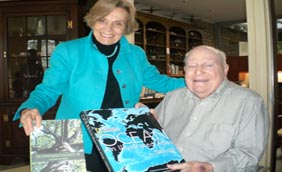 Dr. Sylvia Earle, a global authority on the ocean and Explorer-in-Residence at the National Geographic Society, both entertained and warned a packed audience at Aquinas College during the week of Earth Day April 2010. Dr. Earle delivered the 14th annual Wege Foundation Lecture titled, “Without Blue There Is No Green.” In other words, if we don’t start protecting the ocean and its sea life, we face losing the ‘green’ Earth” as well.
Dr. Sylvia Earle, a global authority on the ocean and Explorer-in-Residence at the National Geographic Society, both entertained and warned a packed audience at Aquinas College during the week of Earth Day April 2010. Dr. Earle delivered the 14th annual Wege Foundation Lecture titled, “Without Blue There Is No Green.” In other words, if we don’t start protecting the ocean and its sea life, we face losing the ‘green’ Earth” as well.
The title of Dr. Earle’s latest book title summarizes her global message: The World Is Blue: How Our Fate And The Ocean’s are One. Since all life is interconnected, living things require a healthy ocean. And she did not fudge the need for immediate action: “The next ten years are the most important in the next 10,000. What we do or don’t do to bring the ocean back to life will determine our future.”
Dr. Earle never eats fish. “How could I when I have seen their faces and no two of them look alike!” Since 90% of the world’s tuna are gone and tuna can’t be farm raised, she asked her audience to stop eating tuna in any form now. Instead she asked them to eat three fish that can be replenished by farming: tilapia, carp, and catfish.
Tuna are being fished out of existence by commercial fishermen with their 30-mile long nets. Every year they are taking 100 million tons of fish from the ocean. And 20% of those fish, or 20 million tons of fish, are thrown away as “bycatch.” Three-hundred thousand mammals a year are killed as bycatch.
As the winner of the competitive Ted Prize, Dr. Earle could choose a mission. Hers is to create protected spots in the ocean—Hope Spots—where sea life can’t be removed.
When asked what will happen to commercial fishermen when their fishing beds are taken away, Dr. Earle did not soft-pedal her answer. “They’ll find new work. Learn a new skill.” She pointed out that many people in this economy have had to do the same thing.
Dr. Earle’s short video took her audience into the “deep” ocean with narrative including:
• Only 5% of the ocean has ever been seen
• Exploring the ocean’s “twilight” zone, 400-500 feet down, one scientist has discovered 14 new species every hour
• The first time humans ever saw a photograph of the Earth was July 1969 during the moon landing
Dr. Earle noted that technology has now allowed scientists to explore the ocean as never before. People didn’t used to know about the deep ocean or how humans have depleted marine life the world needs to survive. But now, Dr. Earle said emphatically, “We do know! And if we don’t protect marine life now, future generations will look back and ask, ‘Why didn’t you do something when you KNEW?’’

(Above photo – Peter Wege and world-famous oceanographer Dr. Sylvia Earle exchange books before Dr. Earle delivered the 14th annual Wege Lecture at Aquinas College. Peter autographed a copy of his new book ECONOMICOLOGY II for her, and she signed a copy for him of The Ocean published by the National Geographic Society where she is the Explorer-in-Residence.)
